|
Invasion of England, 1066
The Battle of Hastings
The Tapestry describes Harold's return to England after swearing his oath to William and his report to King Edward. The story then advances forward two years to 1066 and the death of Edward.
The death and burial of King Edward is presented in three scenes whose chronological order is reversed. The first image (1) depicts Westminster Abbey. This is followed by Edward's funeral procession (2) and then his death (3).
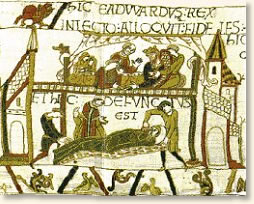 |
The Death of King Edward
|
In this scene (3) Edward is presented as both alive and dead. In the top portion of the panel Edward converses with those gathered at his bedside. The Latin inscription reads "Here King Edward addresses his faithful ones." At the foot of his bed sits Edward's wife who is also Harold's sister. At the side of the bed stands Stigand, the archbishop of Canterbury who performs a religious ceremony. The dying king addresses Harold who kneels in front of him. It is here that Edward supposedly anointed Harold as his successor giving legitimacy to Harold's claim to the crown.
In the lower panel Edward is prepared for burial. The bishop performs last rites while the embalmers go about their work. The Latin inscription reads "And here he died."
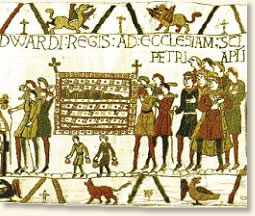 |
King Edward's Funeral Procession
|
Edwards' body, wrapped in linen, is carried to the church for burial (2). The Latin inscription reads "Here the body of King Edward is carried to the Church of St. Peter the Apostle." Edward's burial took place on January 6, 1066.
In its entry for the year 1066, the Anglo-Saxon Chronicle describes Edward's death as follows: "In this year was consecrated the minster at Westminster, on Childer-mass-day. And King Edward died on the eve of Twelfth-day; and he was buried on Twelfth-day within the newly consecrated church at Westminster. And Harold the earl succeeded to the kingdom of England, even as the king had granted it to him, and men also had chosen him thereto; and he was crowned as king on Twelfth-day."
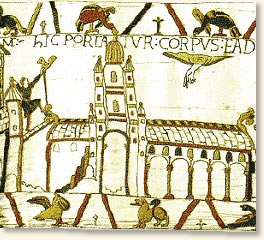 |
Westminster Abbey
|
Edward's funeral procession completes its journey at Westminster Abbey (1). King Edward began work on the abbey in 1050 and construction was completed shortly before his death. The pious Edward was awarded the distinction "the Confessor" for his effort. Unfortunately, the King fell ill on Christmas eve and was unable to attend the abbey's consecration.
The Tapestry conveys the newness of the abbey by the workman affixing the weather vane atop the roof to the left. God's blessing upon the consecrated structure is represented by the hand appearing from the clouds above.
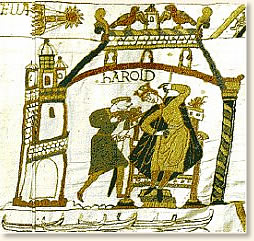 |
Halley's Comet (upper left)
|
Harold is crowned king on January 6. In the spring, near Easter, a comet appears in the sky. The Anglo-Saxon Chronicle describes the event: "Easter was then on the sixteenth day before the calends of May. Then was over all England such a token seen as no man ever saw before. Some men said that it was the comet-star, which others denominate the long-hair'd star. It appeared first on the eve called 'Litania major', that is, on the eighth before the calends of May; and so shone all the week."
We now know that the comet-star in the sky was Halley's Comet making one of its 76-year cyclical appearances. In the Tapestry, an attendant rushes to tell Harold of the celestial happening as he sits upon his throne. The comet appears at the upper left. The portrayal acquires a sense of foreboding as empty long boats appear below the scene. These no doubt presage the invasion fleet William will employ to cross the Channel. The Tapestry implies that the appearance of the comet expresses God's wrath at Harold for breaking his oath to William and assuming the throne. Retribution will be found in the invasion fleet.
Upon hearing the news of Harold's coronation, William immediately orders the building of an invasion fleet. The Tapestry describes in detail the construction of the fleet and preparations for the invasion providing insight into eleventh century building techniques. With preparations complete, William waits on the Normandy shore for a favorable wind to take him to England.
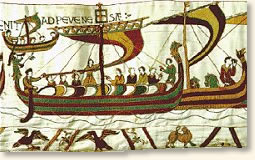 |
William's Flagship
|
The favorable wind arrives on September 27, and the fleet sets sail, its ships loaded with knights, archers, infantry, horses and the lumber necessary to build two or three forts. This scene shows William's ship as the fleet approaches Pevensy on the English shore. A cross adorns the top of the ship's mast. Below the cross, a lantern guides the way for the rest of the fleet. Shields line the ship's gunwales, reminiscent of the practice of the Norman's Viking ancestors. A dragon's head sits on the ship's prow and a bugler blows his horn at the ship's stern. A ship laden with horses sails along side William's craft. The fleet lands on September 28 and the invasion army makes its way to Hastings.
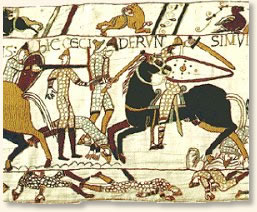 |
The Battle
|
This is one of many scenes depicting the ferocity of the battle. Wielding his battle-axe, a Saxon deals a death-blow to the horse of a Norman. This was the first time the Normans had encountered an enemy armed with the battle-axe. For the Saxons, this was the first time they had battled an enemy mounted on horseback. This scene probably describes the later stages of the battle when the Norman knights had broken through the Saxon shield wall. At the bottom of the scene lay the dead bodies of both Normans and Saxons.
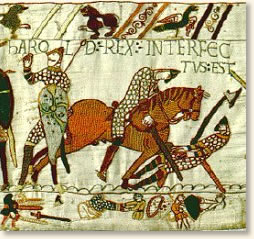 |
The Death of Harold
|
King Harold tries to pull an arrow from his right eye. Several arrows are lodged in his shield showing he was in the thick of the battle. To the right, a Norman knight cuts down the wounded king assuring his death. At the bottom of the scene the victorious Normans claim the spoils of war as they strip the chain mail from bodies while collecting shields and swords from the dead. Scholars debate the meaning of this scene, some saying that the man slain by the knight is not Harold, others contesting that the man with the arrow wound is not Harold, others claiming that both represent Harold. The Latin inscription reads "Here King Harold was killed." The Tapestry ends its story after the death of Harold.
William ruled England until his death in 1087. The Anglo-Saxon Chronicle recalls the Norman King in its entry for that year: "But amongst other things is not to be forgotten that good peace that he made in this land; so that a man of any account might go over his kingdom unhurt with his bosom full of gold. No man durst slay another, had he never so much evil done to the other; and if any churl lay with a woman against her will, he soon lost the limb that he played with. He truly reigned over England; and by his capacity so thoroughly surveyed it, that there was not a hide of land in England that he wist not who had it, or what it was worth, and afterwards set it down in his book."
References:
Bernstein, David, The Mystery of the Bayeux Tapestry (1987); Howarth, David, 1066 the Year of the Conquest (1978); Ingram, James (translator), The Anglo-Saxon Chronicle (1823); Wood, Michael, In Search of the Dark Ages (1987).
How To Cite This Article:
"Invasion of England, 1066," EyeWitness to History, www.eyewitnesstohistory.com (1997).
Return to Part One
|






